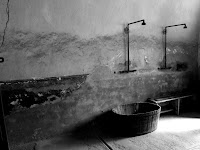 thinking about Terezin (Theresienstadt) in the Czech Republic which was a building project contemporary to Sade, and then redeployed as an internment camp and site of alleged cultural fulfillments . . .
thinking about Terezin (Theresienstadt) in the Czech Republic which was a building project contemporary to Sade, and then redeployed as an internment camp and site of alleged cultural fulfillments . . .http://ww2panorama.org/panoramas/terezin
http://photo.net/travel/bp/terezin
http://www.interdisciplinary.neu.edu/terezin/index.htmlx.html
http://www.deathcamps.org/reinhard/terezin.html
http://www.jocund.org/series/Terezienstadt/
http://www.mediapiculture.net/360days/qtvr/ww2p/85terezin.html
 not thinking so specifically about the history of Terezin, but thinking about the fundamental shapes and architectures that organized these refugee/(economically and
not thinking so specifically about the history of Terezin, but thinking about the fundamental shapes and architectures that organized these refugee/(economically andculturally) incarcerated communities - apparently a co-product of the vision of the 'construction' of 'utopic' communities (think the despotism we might find in Africa, the hope of Israel, the current immigration legislation aimed at illegal immigrants/Mexicans in the States, the Canadian Indian Act . . . )
What I do find interesting about Terezin is the veneer of the civilizing Architecture: it had the
 original shape of a refined and cultivated 18th c. military establishment, with the tyranny of entablatures and cornices and the organized 18th c. plan of the community quite intact - not a stockyard, not Abu G - but there were indeed perforations in the fabric of this veneer, for example the diminutively laid railway, like sewing needles stuck into the Oasis floral foam . . . (flower arranging : yet another insistence upon the utopic other)
original shape of a refined and cultivated 18th c. military establishment, with the tyranny of entablatures and cornices and the organized 18th c. plan of the community quite intact - not a stockyard, not Abu G - but there were indeed perforations in the fabric of this veneer, for example the diminutively laid railway, like sewing needles stuck into the Oasis floral foam . . . (flower arranging : yet another insistence upon the utopic other)




1 comment:
A 1965 East German production directed by Hans Perten set the play (or at least suggested the setting of) a concentration camp rather than a mental institution. Weiss celebrated this particular production because it posited Marat as a socialist hero and for characterizing the inmates (the masses) as "political prisoners" (34). Much of the script was cut or changed for this production to work, but Weiss seemed not to pay attention to this fact. Weiss was also "impressed by the way [Perten] had clarified the dialiectical features" (33) of the play. Weiss celebration of this particular production (almost an adaptation) of his play was one phase in what was apparently a constantly changing attitude towards the meaning and staging of this play.
(Ellis, Roger. “Commited Writing and Marat/Sade.” Peter Weiss in Exile. Ann Arbor: UMI Research, 1987. 23-41)
Post a Comment